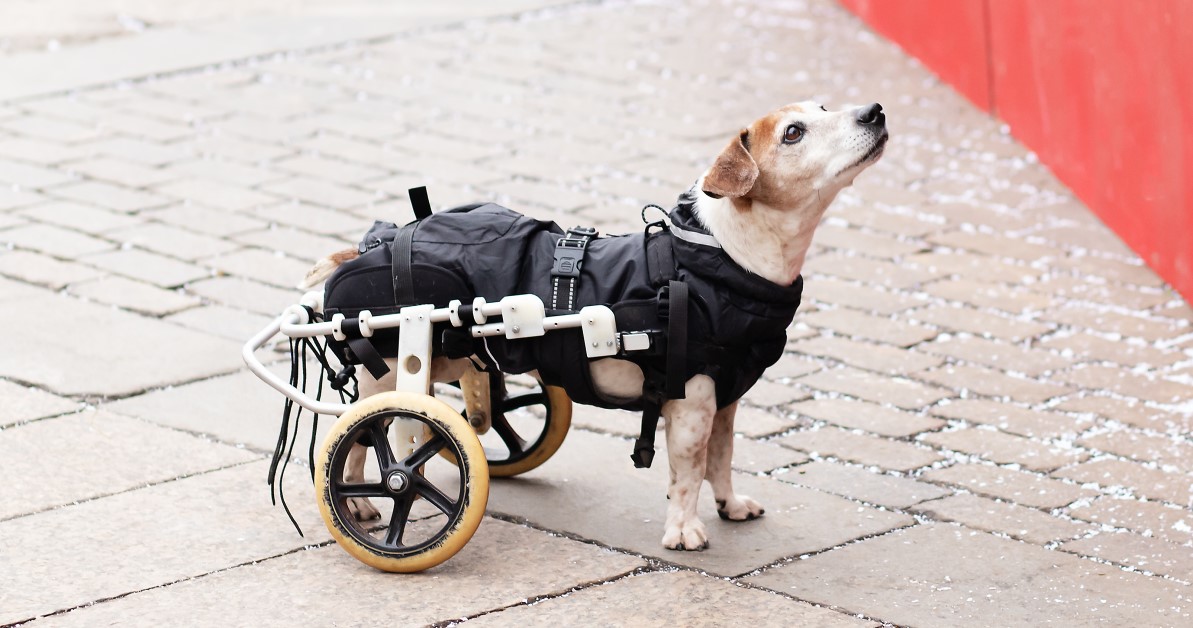Caring for Dogs and Cats With Leg Disabilities
This article explains how to help dogs and cats with leg disabilities thrive.

You'd love your pet regardless of any disability - whether it was present from birth or developed due to illness or injury. Even so, there's no denying that disabled dogs and cats have special needs that can prove challenging if you don't know how to address them effectively. For instance, leg disabilities can interfere with everything from personal hygiene to mobility. If your pet has a leg disability, the following tips can help you give your best friend the best possible quality of life.
Understanding Your Pet's Leg Disability
The first step in helping a disabled cat or dog involves understanding the nature of the disability. In some cases, such as a knee ligament tear or foot fracture, the disability may resolve itself or respond to veterinary treatment. Even a leg amputation can be accommodated over time, since dogs and cats tend to adapt to a three-legged lifestyle with surprising ease.
Other disabilities can present more difficult challenges. A chronic pain condition such as degenerative osteoarthritis may cause ongoing pain, stiffness, or lameness despite treatment efforts. A spinal nerve injury may create partial or total paralysis that makes normal walking or standing impossible. Your veterinarian can educate you on what degree of recovery you can expect for your disabled pet, as well as what steps you should take to pursue further treatment or assistive care.
Ensuring Comfort
First and foremost, you want your dog or cat to feel as comfortable as possible despite the leg disability. Disabled dogs and cats that experience chronic or acute pain from their condition may benefit from medication, therapeutic massage, laser therapy, acupuncture, and other pain management measures.
A paralyzed pet that can't shift its position periodically may develop painful skin ulcers called bedsores. If your dog or cat has paralyzed legs, get into the routine of rotating her or changing her position every few hours to prevent these sores from developing. Extra thick and soft bedding material can also reduce the risk of bed sores and improve comfort.
Providing Assistance with Hygiene
Leg disabilities can interfere with certain aspects of a dog or cat's personal hygiene. For instance, cats may have trouble grooming their hindquarters if they can’t lift and move their rear legs normally. Paralysis that affects the rear legs can also affect bladder and bowel control. your pet may leak urine or stool, or may have the opposite problem and be unable to pee or poop on her own.
If your cat's coat looks scruffier than it once did due to inefficient self-grooming, occasional bathing and brushing can help maintain healthy skin and hair. If your pet eliminates involuntarily, you can purchase pet diapers to catch any accidents. However, you must also make a point of cleaning off any traces of waste before they cause skin irritation, anal gland problems, or urinary tract infections. Your veterinarian can recommend soothing wipes to help keep your pet's bottom and anal glands clean. Since baby wipes designed for humans can irritate a dog or cat's skin, make sure to use wipes specifically designed for pets.
Helping Your Pet Get Around
Even disabled cats and dogs need regular exercise to help maintain their strength, flexibility, and overall wellness. Exercise can even help certain conditions that cause pain, stiffness, and lameness in pets. For instance, studies indicate that swimming, easy walks, and other low-impact exercises can help manage arthritis pain.
Pet Slings and Wraps
How do you exercise an animal that simply can't walk normally under its own power? Assistive devices can come to your rescue in this situation. If your pet finds walking painful, you can wrap a towel under your pet's midsection and lift gently to reduce the burden on his legs. If you expect that your pet will need this kind of support on a permanent basis, you can purchase a professionally-designed pet sling to accomplish this task.
Pet Wheelchairs
A dog or cat with paralyzed rear legs can often get around amazingly well with the aid of a pet wheelchair. If a support towel or sling isn't sufficient to help your pet walk easily, consider investing in this option. Pet wheelchairs come in a variety of basic sizes which also allow you to customize the device for an ideal fit.
A typical pet wheelchair consists of a pair of wheels that assist the rear legs. Metal rails connect the rear wheels to straps that secure the device to your pet's body. If your pet's front legs tend to splay outward when you support him with a towel or sling, you might need to purchase a model with four wheels instead of two. You can even find wheelchairs with tires designed to perform well on specific types of terrain.
Don't Let a Leg Disability Hobble Your Pet's Quality of Life
As you can see, leg disabilities can prove challenging, not only for disabled dogs and cats, but for their owners as well. Fortunately, you have the ability to give your disabled friend a happy, fulfilling life by following the above tips. Make sure your pet receives regular veterinary attention, and shower your beloved friend with all the affection she wants and needs from you.
Ready to start saving money on pet wellness care?
Then take a look at Mint Wellness, the pet wellness plan that provides fast reimbursement on routine pet care. Save on vaccinations, wellness exams, preventatives, dental, and more!
Learn More


